
of Polish Academy of Sciences



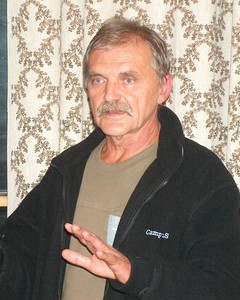
Name: Lesław Zabuski
room: E14
phone: (+48)585222974
e-mail: c30e205ef58ba5b225c14597de104829a7afc1
ORCID: 0000-0003-0270-4477
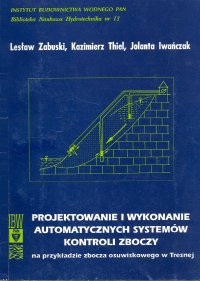 Zabuski L., Thiel K., Iwańczak J.
Zabuski L., Thiel K., Iwańczak J.
Projektowanie i wykonanie automatycznych systemów kontroli zboczy na przykładzie zbocza osuwiskowego w Tresnej
publisher: Wydawnictwo IBW PAN
ISBN: 8385708022
published in: 1992
language: pl
Summary:
Formation of water reservoirs in the mountain regions is a frequent reason of activation of old or development of new landslides on the embankment slopes. Such landslides are unfavourable and in some cases dangerous phenomena. Therefore their registration, observation and forecasting is the matter of the great importance. These activities are carried out using many different methods and means. The most simple is a general periodic inspection of the reservoir embankments. In some cases very sophisticated observations should be carried out, in which specialized measurement equipment is installed, which forms the monitoring system.
Such system, installed on the landslide slope in Tresna near Żywiec is described in the study. The slope is situated on the embankment of Żywieckie Lake – artificial reservoir formed in 1966 on Soła River after construction of Tresna Dam. There was an old landslide on the slope, which was reactivated due to reservoir filling. The monitoring system, named ASKOT was designed and installed on the slope in 1986-90.
The subject of the study is the description of the problems, which concern ASKOT installation. The problems presented can be divided into three groups. In the first group general considerations regarding the needs, objectives and methods of the slope monitoring are presented. ASKOT is a first system installed in Poland, thus such considerations are necessary. The second group contains the results of interdisciplinary investigations and measurements (e.g. geology, geotechnics, geophysics, displacement measurements, etc.), carried out before and during the installation of the system. The third group concerns the structure and construction of ASKOT.
The slope inclined at 14 degrees is formed of typical Carpathian flysch rocks – i.e. sequentially lying beds of sandstone and clay shale. The slides of the rock mass are observed at different depths in the shales. Slide surfaces were detected using different methods. The inclinometric measurements were recognized as most efficient and accurate, as they allow to find any slide surface which is contemporary active. It was stated that the main reasons, determining slide movement are the fluctuations of the underground water table (GWL) in the slope and changes the water level in the reservoir. These phenomena are strongly related with precipitations. These dependencies are discussed in the study.
ASKOT was designed and installed basing on the general principles, given in the first group. The results of the former investigations and measurements were also taken into account. It can be described as “cause-effect” system, i.e. the system, which records the quantities influencing the state of the slope (GWL, water level in the reservoir) and being the causes of its instability and the quantities which are the attribute (effect) of instability (slope deformations). The piezometric gauges were installed in the boreholes on the slope, to record the GWL, whereas the displacements were measured by fixed-in-place borehole inclinometers, located at the depths of the active slide surfaces. The limit values were determined, i.e. maximum admissible values for the quantities measured. It was assumed that the critical state of the slope is reached if the value of some quantity reaches or exceeds the limit value.
The gauges arranged on the slope are electrically connected with the measurement centre. The principal part of this centre is the measuring unit, automatically connected with the gauges in time of the measurement action. Both the gauges and the unit act on the principle of the vibrating wire. The remote control of the measurements is provided using microcomputer which is logically connected by the interface to the measurement unit, so the later “understands” the signals from the microcomputer and record the results as well as “translates” them into physical quantities. The ASKOT structure could be modified, e.g. by adding the new gauges or installing the alarm set, etc.
The study gives some contribution to the recognition of the landslide processes in the nearest vicinity of the water reservoirs as well as it gives some practical and theoretic aims, which possibly could help to install the systems allowing to monitor the state of the slopes.
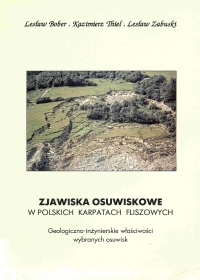 Bober L., Zabuski L., Thiel K.
Bober L., Zabuski L., Thiel K.
Zjawiska osuwiskowe w polskich Karpatach fliszowych, Geologiczno-inżynierskie właściwości wybranych osuwisk
publisher: Wydawnictwo IBW PAN
ISBN: 8385708235
published in: 1997
language: pl
Summary:
The book is elaborated basing on the results of the realization of the Polish Scientific Committee research project “Investigations and analyses of the rock slopes stability in Carpathian flysch”. It contains the sets of geological-engineering data and informations for 37 selected landslides, situated in the region of Carpathians in Poland. The results of own investigations, as well as performed by the other authors are utilized. The main objective of the study is possibly in-depth and systematic presentation of morphology, geological structure, hydrogeological conditions of the landslide slopes, as well as the mechanisms and causes of the landslides initiation and progression. Thanks to its structure and scope the publication could be considered as a catalogue, in which the landslides are described in turn, divided into four groups. The criterion of this division is the orientation of the rock layers with respect to the terrain surface. The list of the landslides in each group is preceded by the schematic figures and concise definitions, explaining the terms, which constitute the criteria of this division. At the beginning of the publication, schematic map is presented with the location of each described landslide, as well as the explanations of signs and labels used on all landslide maps, cross-sections and excavations (e.g. shafts, boreholes) are given. The list of references is given at the end of the book, enabling the reader to find the original publications, creating the basis for preparation of the study.
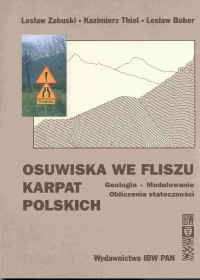 Zabuski L., Thiel K., Bober L.
Zabuski L., Thiel K., Bober L.
Osuwiska we fliszu Karpat polskich: geologia - modelowanie - obliczenia stateczności
publisher: Wydawnictwo IBW PAN
ISBN: 8385708332
published in: 1999
language: pl
Summary:
The study contains the results of the comprehensive, interdisciplinary investigations of the landslide phenomena in Carpathian flysch. It is divided into two principal parts. The geological aspects of the slopes stability are described in the first part. It contains the description of the geological properties of the rock mass, especially important from the point of view of their influence on the slope stability. The problems connected with the systematisation of the mass movements and with the phenomena influencing the state of the slopes are analysed. The investigations history of the Carpathian landslides is shortly presented. The “landsliding” in flysch are next characterized (A. Kleczkowski defines this phenomenon as “repeated tendency to sliding, caused by the external conditions and connected with the internal causes”), with taking into account the geological structure of the massif. The “external conditions” act on the object from outside, whereas the “internal causes” are connected with geological structure of the rock mass composing the slope as well as with hydrogeological conditions and also with terrain morphology. The quantitative estimation of landslides appearance in different regions of Carpathians is proposed and geological classification of the slopes from the point of view of susceptibility to sliding is presented.
Mechanical properties of the flysch rock mass are characterized, the mechanical models are discussed and results of the stability calculations are presented in the second part of the study. The geological properties described in the first part are considered as an input data to the models discussed here. It should be mentioned that the example slopes analysed in this part are partially fictitious. The extensive list of references is included at the end of the study. The appendices are also enclosed. They contain the example data regarding the material losses caused by the landslides in Carpathians, listings of the mechanical parameters of the flysch rocks and rock masses, description of the original distinct element method, which was used in the stability analysis of the slope composed of discontinuous rock mass.
 Zabuski L.
Zabuski L.
Zachowanie się fliszowego ośrodka skalnego w otoczeniu konstrukcji podziemnej na przykładzie tunelu na niedużej głębokości
publisher: Wydawnictwo IBW PAN
ISBN: 8385708480
published in: 2002
language: pl
Summary:
The book gives the investigation results of the tunnel and surrounding flysch mass behaviour in the experimental object at Świnna Poręba, during the excavation of two hydrotechnical tunnels. The tunnels were excavated at a shallow depth –; from 0 to 55 m. “Shallow depth” means such depth of the tunnel for which the influence of superficial phenomena on the properties of the rock mass situated between tunnel and terrain surface is noticeable.
Investigation of the tunnel behaviour required the applying of interdisciplinary methods. Investigations of geological-engineering and mechanical properties of the rock mass and its description enabled the formulation of rock mass models. Simultaneous with excavation progress, systematic displacement measurements were carried out, their results constituting the basis for statistical analyses of the tunnel deformations. The results of the measurements enabled the formulation of rules governing deformation processes. A numerical analysis was carried out to determine the stress and deformation distribution and evaluate failure processes in the rock mass. Verification of these was possible on the basis of their comparison with the results of measurements. Calculation results show the processes observed inside the rock mass and thus explain the reasons for deformations observed in the tunnels.
The results could be considered to be a contribution to the description of the behaviour of flysch rock mass during shallow tunnel excavation. Special attention should be paid to the formulation of rock mass mechanical models, to determining dependencies allowing for displacement prediction, as wee as to the description of the phenomena associated with excavation ad initiated in front of the tunnel heading face. Methodological results should also be mentioned –; some conclusions constitute the basis for modelling procedure of rock mass for numerical simulation of excavation processes.
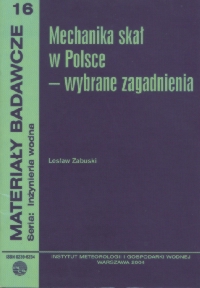 Zabuski L.
Zabuski L.
Mechanika skał w Polsce - wybrane zagadnienia
publisher: Instytut Meteorologii i Gospodarki Wodnej
ISBN:
published in: 2004
language: pl
Summary:
Selected problems are described in the study, which nowadays are the matter of rock mechanics investigations in Poland. It is composed of six chapters. The first contains introduction. Principal trends of the research are discussed in the second. The new materials used to the construction of tunnel linings and to the reinforcing of the rock foundations and slopes are described in chapter 3, whereas chapter 4 is devoted to the description of the geomechanical and numerical models, applied in the stability analyses and deformation processes of the rock masses and constructions founded in/on them. The monitoring procedures developed in tunnelling and landslide observations are presented in chapter 5. Chapter 6 contains the summary and the remarks regarding the future trends of the rock mechanics in Poland.
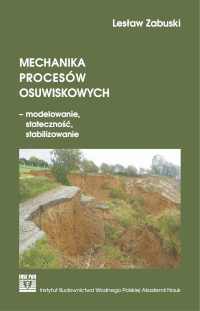 Zabuski L.
Zabuski L.
Mechanika procesów osuwiskowych - modelowanie, stateczność, stabilizowanie
publisher: Wydawnictwo IBW PAN
ISBN: 9788385708896
published in: 2022
language: pl
Summary: Despite numerous studies aimed at investigating various aspects of landslides, these phenomena have not received a comprehensive study, mainly in the field of engineering geology, discussing methods and results of geomechanical modelling of landslides taking into account the results of natural (geological) studies. In fact, the focus has been on single landslides taking into account geological or geological-engineering aspects. The monograph presented here considers rock and soil mechanics issues, discussing purely geological issues to a lesser extent. At the outset, the history of research on Carpathian landslides is briefly discussed and then — against the background of geological structure of the Carpathian flysch area — the characteristics of landslides are outlined, which A. Kleczkowski (1955) defines as „a recurrent tendency to landslides, caused by external conditions or internal causes”. External conditions are factors affecting the object from outside, while internal causes are usually a reaction to external factors (conditions). In addition, a description of the mechanical properties of the flysch medium, its geomechanical models and the results of slope stability calculations are presented. The geological properties here constitute the „input” information for geomechanical analyses. They include the results of analysis of stability and deformation processes of exemplary slopes — in part selected from the sites collected in the above-mentioned monograph, as well as model (fictitious) slopes. Much attention is paid to methods of monitoring the behaviour of landslide slopes, showing example solutions and measurement results. An extensive chapter deals with slope stabilisation methods. The inclusion of many examples of various types of analyses, studies and measurements is an important feature of the monograph. This is due to the author's belief that the best way to consolidate and understand certain studied and solved tasks is to illustrate them with an example. In spite of a certain subjectivity, the work includes important issues for the recognition of the title mechanics of landslide processes — their modelling, stability analyses, stabilisation and monitoring of landslides - which are relevant and even, as is likely, may dominate in the future. These include, for example: